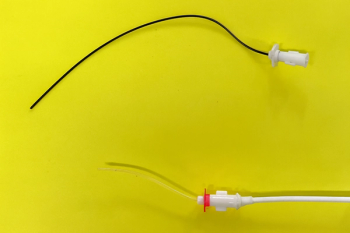
Nonsurgical urolith management (Proceedings)
Successful management of urolithiasis in dogs and cats depends upon the removal of existing uroliths and preventing their recurrence. Traditionally, uroliths have been removed via surgery.
Successful management of urolithiasis in dogs and cats depends upon the removal of existing uroliths and preventing their recurrence. Traditionally, uroliths have been removed via surgery. However, depending on the location, size, number and composition of the uroliths, less invasive techniques may be equally as effective. Options for non-surgical stone removal include; medical dissolution, spontaneous voiding, catheter retrieval, voiding urohydropulsion, basket retrieval, laser lithotripsy, and extracorporeal shock wave lithotripsy. Although many types of uroliths tend to recur, careful management and frequent monitoring may help to minimize recurrence. Although there are many acquired disease conditions that can contribute to stone formation, many animals (and people) are genetically predisposed to developing specific stones types (e.g. Dalmatians and urate stones). To avoid incorrect assumptions (and thus therapy) concerning the mineral composition of uroliths, all uroliths that are retrieved should be submitted for quantitative mineral analysis. The Minnesota Urolith Center will analyze uroliths at no charge; submission forms are available online.
The first step to preventing new stone formation is to ensure that all current stones are removed. The most common cause of rapid recurrence of uroliths is incomplete removal. If any small stones are left in the bladder they act as scaffolding resulting in the formation of larger stones quickly. Stones are frequently left behind following cystotomy as flushing fluid through the urethra may not be a reliable method of moving uroliths. This is especially true for uroliths with an irregular contour (e.g. calcium oxalate and silica) which allow catheters and saline to slide pass uroliths lodged in the urethral lumen. To verify complete urolith removal, radiograph the entire urinary tract immediately after any stone removal procedure. If uroliths are detected, consider their immediate removal as long as the patient is stable. Without post-surgical radiography, it will be difficult to distinguish recurrence of the uroliths from failure of removal as a cause for recurrence of clinical signs.
Options for non-surgical stone removal
1. Medical dissolution
Medical dissolution is the least invasive method of stone removal, but is only effective for certain types of uroliths in certain locations. Uroliths that may be medically dissolved include only struvite, urates, and cystine. Calcium oxalate and silica uroliths cannot be medically dissolved. For dissolution to occur, the uroliths must be surrounded by/bathed in dilute urine of the proper composition to allow the crystals to go back into solution. This is most likely to occur in the bladder. Nephroliths, urethraliths and ureteroliths are less likely to dissolve. A calculolytic diet specific to the stone type in question must be fed exclusively throughout the dissolution. In dogs, the majority of struvite stones result from urinary tract infections that change the urinary pH, thus strict infection control is essential for dissolution. Antimicrobial therapy must be given throughout the entire dissolution period as viable bacteria are contained within layers of struvite uroliths. Antibiotic and dietary therapy should be continued for at least 1 month following radiographic dissolution of the stones. Once uroliths are removed, preventative therapy should be initiated to reduce recurrence.
2) Spontaneous Voiding
Very lucky patients may spontaneously void their stones. Due to the anatomy of most quadripeds, the dependent portion of the bladder is located below the outflow tract, predisposing to the retention of bladder stones. Unfortunately, even the most well-behaved and obedient patients are not likely to urinate on command while standing on their hind legs. However, occasionally, a patient will void small stones during forceful urination, or if the stones become suspended in solution after exercise. Owners may be instructed to collect urine at home and strain through a fine meshed fish net in order to collect stones for analysis.
3) Voiding Urohydropulsion
Voiding urohydropulsion is a non-surgical option for removal of some stones. This technique relies on hydrostatic force, from bladder compression, to propel the stone through the urethra. The patient is placed under general anesthesia to relax the abdominal musculature and the bladder, which is then distended with saline via a cystoscoy or a urinary catheter. The patient is re-positioned so that their spine is vertical (like a person standing). The bladder is compressed manually to initiate a detrussor contraction which is then supported with additional manual compression to forcibly express the saline, and hopefully the stones. This procedure may need to be repeated a few times to remove all stones. The size of stone that may be removed will depend upon the size of the patient and relative size of the urethra. Irregular stones are more difficult to remove as it may be difficult to generate adequate force if saline passes around the stone. Complications associated with this procedure include hematuria, not retrieving all stones, having a stone become lodged in the urethra, and rarely, bladder rupture. After the procedure, complete stone removal may be verified via cystoscopy or contrast radiography. Standard survey radiographs may not identify small stones that are left behind. It is very important to verify that the patient does not have an active urinary tract infection prior to performing voiding urohydropulsion as the force exerted when expressing the bladder could inadvertently cause retroflux of infected urine into the kidneys resulting in pyeloneohritis.
4) Lithotripsy
Many owners inquire about lithotripsy when learning that their pets have urinary tract stones. There are two categories of lithotripsy:
a) Extracoporeal Shock Wave Lithotripsy (ESWL): This procedure uses repeated shock waves generated outside of the body to fragment stones into pieces small enough to pass through the urinary tract. Unfortunately, this modality has not been as useful in small animals as it has in humans due to the differences in patient size and urolith characteristics. The usefulness of extracorporeal lithotripsy is also limited by availability. Currently, ESWL is available only at Purdue University and the University of Tennessee.
b) Laser Lithrtripsy: Laser lithotripsy is an excellent option for stone removal in selected cases. Briefly, a small diameter yag holmium laser fiber is passed through the working channel of a cystoscope. The laser super-heats water inside the stone causing it to fragment, and the fragments are then removed with a stone basket, or voiding urohydropulsion. The energy from a yag holmium laser is absorbed in 0.5 mm of fluid, which allows for efficient fragmentation of stones with minimal trauma to the urethral mucosa. Laser lithotripsy is a safe and efficient way to remove lower urinary tract stones with the added benefit of a significant reduction in healing time compared to cystotomy or urethrotomy. Laser lithotripsy is available at select Veterinary colleges and a few large referral practices.
Minimizing Recurrence
Once the stones have been removed from a patient, the focus of management must shift toward preventing recurrence. Many stone types have a high rate of recurrence and client education is vital to successful management. It is critical that all stones be submitted for quantitative analysis so that therapy may be tailored to the individual patient. Dietary recommendations will depend on the composition of the stones, and a canned diet is preferable to kibble. Regardless of stone type, increased water consumption is recommended as it will result in more dilute urine which is less likely to promote stone formation.
Ongoing monitoring is an extremely important part of stone management. A urine sample should be analyzed 2-4 weeks after the stones are removed to ensure that the urine is dilute and at an adequate pH. If the urine is not adequately dilute, water consumption will have to be increased (either by adding water to the food, increasing the amount of canned food, etc.). Radiographs should be taken once every three months or whenever lower urinary tract signs are present.
Newsletter
From exam room tips to practice management insights, get trusted veterinary news delivered straight to your inbox—subscribe to dvm360.



